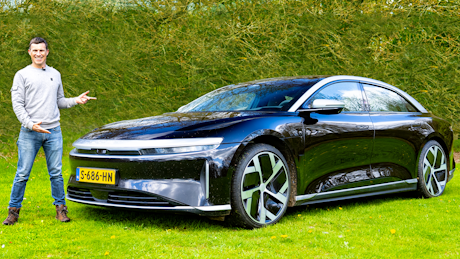Lucid Air review: Tesla Model S alternative driven
May 11, 2023 by Jack Healy

Lucid Air Performance Dream Edition specs
Engine: Dual electric motors – one on each axle
Power: 1,111hp
Top speed: upwards of 200mph
0-60mph: 2.4 seconds (with one-foot rollout)
Price: £193,000 (before options)
Lucid Air design
Cars are getting more aerodynamic and streamlined these days, as electric cars have become more common – the slippery shape helps maximise range. But the most aerodynamic production car in the world is this, the all-electric Lucid Air.
With a drag coefficient of just 0.19 Cd, that’s better than the pebble-smooth Mercedes EQS and quarter-mile blitzing Tesla Model S Plaid. And it’s all down to some clever design elements.

At the front, you get inlets in the nose leading to openings in the bonnet and at the side of the front bumper to smooth airflow over and around the body, while the grille at the bottom only opens when the electrical components need cooling.
Down the side, you get the option of a two-tone body to emphasise the sleek roofline and nice pop-out door handles, while you can choose between 19-, 20- or 21-inch alloy wheels – the smaller the better in terms of range, the larger the better for the Air’s looks.

The back end has a lot of tidy elements, including a full-width lightbar, an integrated bootlip spoiler and nice lines emphasised by some more chrome.
Compared to the aforementioned EQS and Model S, the Air is arguably the best-looking luxury electric saloon on sale at the moment.
Lucid Air interior
While Tesla suffers from quality issues, the Lucid Air only suffers from a slightly squeaky seat and steering wheel – if our test car was to be believed. But beyond that, the Air has a much nicer cabin.
First off, you get a normal steering wheel as standard – no yoke found here at all – and you get some lovely lines and materials to make you feel like you’re in a premium product. Soft surfaces and a solid build make the Air an excellent place to be.

Lucid has also taken a different approach when it comes to screens. Your main infotainment touchscreen is actually mounted to the side of a curved unit behind the steering wheel, with the driver’s display in the middle and light controls on a touch-sensitive panel on the other side. It’s like a bigger version of Porsche’s screen in a Taycan and next-gen Cayenne – and we like it a lot.
A secondary touchscreen for more detailed settings is in the centre console and although that can be a little fiddly to use when you’re driving, it has a secret skill. Press a button at the bottom and it folds up to reveal further storage, which is otherwise difficult to get to and that adds to the other storage space in the centre console.

The seats are very comfy and you have a nice seating position to allow for long distance driving with minimal fuss. But the highlight is the full-length glass roof. It has some structural bracing breaking it up but it brings lots of light into the cabin, making the interior feel spacious and even more premium.
For passengers, the Air caters to them well too. You get loads of legroom – more than a Mercedes EQS – and decent headroom, even with the sloping glass roof. It’s a lovely place to be.
Lucid Air driving
In the Performance Dream Edition we got our hands on, you get two electric motors (one on each axle) that develop 1,111hp and 1,390Nm of torque. That’s a serious amount of punch from a luxury saloon.
Using all of the performance, you can go from 0-60mph in just 2.4 seconds. Lucid has cheated a little with that figure though, as like Tesla it uses one-foot rollout to achieve its numbers. When launching from a standstill, Mat was able to get to 60mph in 2.95 seconds, which is impressive – although that’s slower than the Model S Plaid’s 2.4 seconds in a similar test. This isn’t the ultimate version of the Air though, as the tri-motor Sapphire is more of a Plaid rival with over 1,200hp and a similar claimed 0-60mph time as the Tesla.

When you’re not blitzing a quarter-mile, the Air settles down to be a comfortable cruiser – but it’s not perfect. The suspension at slower speeds doesn’t soak up bumps quite as well, and when tested on 21-inch alloys, the Air can feel quite firm. The steering is light though, having a similar turning circle to the Mercedes EQS and all-round cameras to help with parking.
Out on the motorway, you can make the most of the dual motors, getting up to speed impressively quickly. Once you’re at cruising speed, you can let the car take the strain with its adaptive cruise control, and apart from a slight flutter from the wing mirror, it’s very quiet.

The 118kWh battery allows for long-distance cruising. But to get the most out of the pack, you need to drive pretty carefully to get towards the claimed 511 miles on a single charge. With normal driving in mixed conditions, you’re more likely to see around 350 miles.
Going down a twisty road in its sportiest Sprint mode lets you punch out of corners impressively, but with limited feel from the tyres it’s not a particularly exciting car to use when tackling a back road.
Lucid Air verdict
As a Tesla Model S alternative, the Lucid Air could be a smarter and more interesting option. But it’s much more expensive than the Tesla and isn’t quite as fast – you’ll have to wait for the Sapphire version for that.















